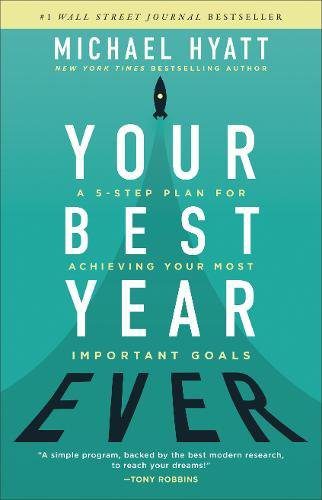In Your Best Year Ever: A 5-Step Plan for Achieving Your Most Important Goals, NYT Bestselling Author and Speaker Michael Hyatt describes a five step process for setting and achieving goals. The 5 Steps are: Believe the Possibility, Complete the Past, Design your Future, Find Your Why and Make it happen.
LifeScore
Life consists of ten interrelated domains. Understanding the relative health of each can help you make progress across them all. Our lives consist of ten interrelated domains:
- Spiritual: Your connection to God
- Intellectual: Your engagement with significant ideas
- Emotional: Your psychological health
- Physical: Your bodily health
- Marital: Your spouse or significant other
- Parental: Your children if you have any
- Social: Your friends and associates
- Vocational: Your profession
- Avocational: Your hobbies and pastime
- Financial: Your personal or family finances
Goals poorly formulated are goals easily forgotten.
Step 1: Believe the Possibility
If our habits of thinking are beneficial, we tend to experience positive results, such as happiness, personal satisfaction, even material success. If our habits of thinking are counterproductive, however, we often experience the opposite: unhappiness, dissatisfaction, and the nagging feeling that the deck is somehow stacked against us.
Limiting Belief – Liberating Truth
We all face obstacles. While limiting beliefs prevent us from overcoming them, liberating truths help us transcend obstacles and improve our circumstances.”
It’s hard to get your hopes dashed if you never get them up to begin with. But that kind of cynicism poisons our souls and sabotages our results. Our beliefs about what’s possible have a direct impact on the reality we experience.
“When we obsess on what’s wrong, we miss what’s right. It skews our view and blinds us to opportunities all around us.”
Step 2: Complete the Past
Sometimes we live inside unhelpful stories we tell ourselves. Other times we nurse grievances to justify our current actions or feel unvalued because we were slighted or disregarded in some way. If we don’t get resolution, we’ll drag all our unfinished business into the future, and it will sabotage everything we’re trying to build going forward.
The Gratitude Advantage
The truth is that you will never have more of what you want until you become thankful for what you have. Ingratitude creates instant victims in our culture of scarcity. But giving thanks for outrageous abundance inoculates us from the sense of fear, failure, and discontent we sometimes experience and instead creates a path toward success, joy, and fulfillment.
Step 3: Design your Future
Great results don’t just happen. You don’t usually drift to a destination you would have chosen. Instead, you have to be intentional, force yourself to get clear on what you want and why it’s important, and then pursue a plan of action that accomplishes your objective. Step 3 is designed to help you find the clarity you need so you can create the life you want.
Do not think or do anything without having some aim in sight; the person who journeys aimlessly will have labored in vain. – MARK THE MONK, On the Spiritual Law
Achievement vs Habit Goals
Achievement goals are focused on one-time accomplishments. They might target paying off your credit cards, hitting a financial benchmark, or finishing writing a novel. It’s essential that achievement goals include deadlines.
Habit goals, on the other hand, involve regular, ongoing activity, such as a daily meditation practice, a monthly coffee date with a friend, or walking each day after lunch. There’s no deadline because you’re not trying to accomplish just one thing. You’re trying to maintain a practice. Instead, there’s a start date, which triggers initiation.
The Zones of Goal Setting
The three zones are the Comfort Zone, the Discomfort Zone, and the Delusional Zone.
If we want to win, we need to get beyond our natural urge to play it safe, jump outside our comfort zones, and set some risky goals. Now imagine if that growth goal was more like 20 percent. Delivering that result will require more from you than you currently know how to manage. That’s when growth happens.
The Comfort Zone
We all have dreams for a better future. We set goals for improving our health, our family and friendships, our finances, our work lives, and more. When we start dreaming about the future, however, our aspirations can feel too fragile and too far away. We jump ahead of ourselves and start worrying about how we’re going to achieve those goals. Then, because we let the how overshadow the what, we downgrade our aspiration. We don’t see how we can accomplish more, so we throttle back our vision, convinced our goals must be “reasonable” or “realistic.” We aim low. We settle for less. And what we expect becomes our new reality.
“For a goal to matter, it has to stretch us. That means it has to stand somewhere outside our Comfort Zone. If you know exactly how to attain the goal, it’s probably not far enough.”
The Discomfort Zone
For a goal to be meaningful, its attainment should lie in the Discomfort Zone. You’ll know you’re there when you start feeling emotions we normally consider negative: fear, uncertainty, and doubt. When rightly understood, these supposedly negative emotions work like indicator lights telling us we’ve arrived. When we don’t see the path, or we’re unsure about having what it takes to reach the goal, then we’re closing in on a goal worth trying for.
The Delusional Zone
Some goals are simply impossible and fail to align with the rest of our priorities. They don’t inspire; they ensure failure. Risky goals are a must. That means discomfort is a positive indicator. When you set goals, avoid staying in your Comfort Zone. Be sure to avoid the Delusional Zone too.
“Goals in the Discomfort Zone challenge us and summon our best performance. Goals in the Delusional Zone invite defeat and merely leave us frustrated and discouraged.”
Step 4: Find Your Why
Internal vs External Motivation
External motivation comes from outside influences like society, our friends, our bosses, and so on. External motivations are rarely as long-lasting or effective as intrinsic motivation.
If you want to go the distance, you’ve got to find a reason that speaks powerfully and personally to you.
External motivators can work, but they’re usually less effective in the long run, especially if we lose interest in the reward, get demotivated, and slack off before we’re even aware. Worse, if those external rewards are someone else’s idea—say, a spouse or a boss—we can become resentful of the reward if we’re not careful.
“Intrinsic rewards help us avoid that danger because we connect personally and emotionally with them. You might say they’re self-justifying. They become an end in and of themselves, even part of our identity.”
Step 5: Make It Happen
At this stage of the game, the most important aspect of making it happen is practicing the art of the start. You don’t have to see the end from the beginning. In fact, you can’t if your goal is big enough. And the good news is that you don’t need to. All you have to see is the next step. Any goal is manageable one action at a time.
Activation TriggersTM.
These are simple statements or actions that streamline the process of reaching our goals. By anticipating whatever contingencies or obstacles we might face, we can cue a desired response. Instead of relying on our decision making in the moment (when our mental and emotional resources might be at their lowest), Activation Triggers lock in our decisions in advance.
“It’s hard to make progress when we’re stuck in behavioral ruts. Activation triggers can get us out of the ruts and remind us of new and better behaviors that will help us reach our goals.”
Whatever your goal, the trick is to simply think through the contingencies and obstacles that will prevent you from achieving it. Once you’ve thought through the most likely hang-ups, you can pre-respond so you know what to do the second they occur. It might take a little imagination to think through the potential obstacles to your goals, but it’s worth it. Once you’ve used them a few times, they’ll become second nature.
LEAP Principle:
NEVER LEAVE THE SCENE OF CLARITY WITHOUT TAKING DECISIVE ACTION.
If you want to see a big change, you must be willing to take a big LEAP. It’s as simple as four steps, one for each letter of the acronym:
Lean into the change with expectancy.
When you notice that a change is desirable or necessary, that’s your green light. Punch the gas pedal. That inkling is all you need to get going.
Engage with the concept until you achieve clarity.
Don’t let the feeling pass. Work with it until you’ve got a sense of what to do. That nagging thought in the back of your mind might be the start of a whole new adventure—or the ladder you need to climb out of a deep rut.
Activate and do something—anything.
Sometimes we wait to move until we have all the information. That’s a mistake. Clarity comes in degrees. And you only need enough light for the next step. Even if you get off on the wrong foot, the rest of the journey will become clearer as you go.
Pounce and do it now.
Once you’ve determined your next step, take it. Don’t wait. Waiting feels safe, but waiting kills dreams.
All the Best in your quest to get Better. Don’t Settle: Live with Passion.



2 Comments
Pingback: The Art of the Start. | Lanre Dahunsi
Pingback: 100 Books Reading Challenge 2022. | Lanre Dahunsi